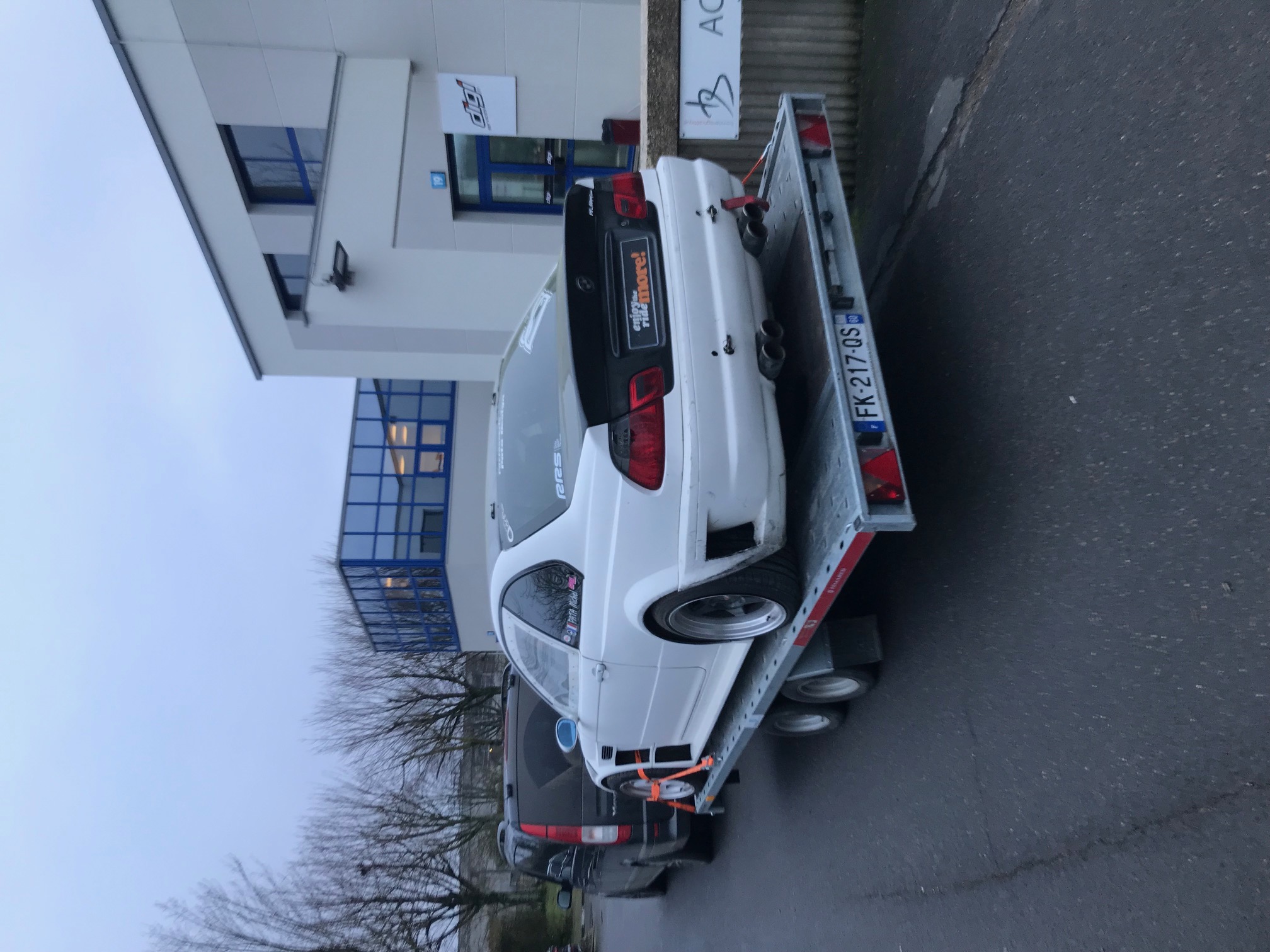
1) PerfectPower: an awesome smartphone application!
2) Functions of PerfectPower (9)
3) The creator of PerfectPower
4) Illustration of PerfectPower performances
1) PerfectPower: an awesome smartphone application!
PerfectPower is the reference on-board system in the field of automotive power and performances measurements!
It is basically a revolutionary smartphone application for measuring power and performances for automobiles which has quickly established itself as the reference smartphone application in the field by being at the same time the most reliable, the most complete, and the most autonomous...
But its results have so far surpassed the "standards" expected from measurements with a simple smartphone to reach the level of pro or semi-pro equipments that it has naturally become THE automotive reference on-board system in power and performances measurements, that presenting the best price / reliability of results / variety of features / operating independence ratio!
1) Unprecedented reliability of results for a smartphone application and comparable to that of professional equipments, since it measures acceleration, speed, and distance with an accuracy of +- 0.5%, and power and torque with an accuracy of +- 1% for a single measurement and +- 0.5% on average of two measurements. All these values have been both theoretically established and proven in practice, as you can check on the site...
Note: Such accuracy is made possible by the accurate, permanent, and clever combination of the informations of the phone accelerometer and the GPS, knowing how to take the best of both sensors while eliminating the specific disadvantages when used individually.
2) Variety of features also unprecedented not only for a smartphone application but also all equipments combined, since it allows to:
- Measure the standardized engine power (DIN, CEE, SAE, JIS, ISO) of your car
- Perform engine development (mapping) with the same efficiency as on chassis dynamometer
- Measure the performances (accelerations, runs flying start, braking, max speed) of your car
- Calculate the gearbox ratios by rev calibration (as on chassis dynamometer)
- Measure the free-wheeling losses
- Simulate the performances of your car (accelerations, runs flying start, max speed, ideal max revs)
- Measure lap times on track
Of course, as its name suggests, PerfectPower specialized in power measurements, which are the most interesting measurements of all in automobile mechanic!
3) Total operating independence, since it requires absolutely no connection to any external equipment (external GPS receiver, car ECU, etc...), which allows it to operate on 100% of the cars produced on the planet, and with only your smartphone as a measuring instrument! This does not prevent it from accepting communication via bluetooth with certain high-performances external GPS receivers in order to further optimize its results accuracy!
4) It only costs... 49 euros & dollars, when:
- a chassis dynamometer (professional power measurement tool) costs between 30,000 and 120,000 euros & dollars!
- a simple pass on such equipment is charged 50 to 120 euros & dollars (without guarantee of maximum reliability!)
- an optical reading system (professional tool for measuring performances: accelerations, runs flying start, max speed, braking) such as that used by the majority of European car magazines costs around 15,000 euros & dollars...
- a Performance Box (semi-professional tool for measuring performances: accelerations, runs flying start, max speed, braking) like this used by the majority of American car magazines and by a certain number of passionate (and wealthy!) amateurs costs 576 euros & dollars!
- any other power and/or performances measurement system of equivalent price (such as the PerfExpert application -of which I am the co-creator- or the PowerDyn software) is far from being able to provide the level of accuracy demonstrated by PerfectPower, while being generally much less complete, and not devoid of constraints (need to perform a very rigorous calibration of the accelerometer and to enter a very complex but above all trap parameter -the pitch- for PerfExpert, car having to be equipped with a OBD plug -PowerDyn OBD-, need to perform a home-made assembly -PowerDyn "standard"-, etc...)
It should be noted that of these four points, it is probably that of operating independence that is the most remarkable, because PerfectPower thus proves that:
- the level of certain technical components (accelerometer, gyroscope, GPS receiver) of a modern smartphone is amazing, and does not require the use of external equipments to improve its already very high performances
- it is the one and only smartphone application able to exploit 100% of the potential of these components, and by far! Indeed, it is obviously not enough to retrieve the informations from the sensors as they are to use them correctly: it is the result of hundreds of hours of work but also of high skills in physics and mathematics, and all developers worldwide who have tried to achieve the level of accuracy of PerfectPower have all failed without exception...
- it is the one and only smartphone application able to transform a simple smartphone into professional equipment, without "resting" as some concurrents do on an external equipment improving the reliability of results, while nevertheless remaining much more reliable than these "helped" concurrents... which once again does not mean that the exceptional results accuracy of PerfectPower can not be further optimized with the support of an external equipment, but just this is not an indispensable condition for obtaining an exceptional results accuracy: test it, and you will understand!
2) Functions of PerfectPower (9)
1) Power
Engine power @ rev
Engine torque @ rev
Wheels power @ rev
Max acceleration @ rev
Max speed @ max rev
Measurement time & Measurement distance
Power / rev and Torque / rev curves
2) Accelerations (runs standing start)
60 ft, 1/8 mile, 1/4 mile, 3300 ft (imperial system) or 20 m, 200 m, 400 m, 1000 m (metric system) (with crossing speeds)
0 – 20 / 40 / ... / 200 mph (imperial system) or 0 - 20 / 40 / ... / 200 km/h (metric system)
Max acceleration @ speed
Max speed @ time
Acceleration / Time and Speed / Time curves
3) Runs flying start
x – y mph or km/h, on gear z (x, y, z chosen by you):
Total time
4) Braking
x – 0 mph or km/h (x chosen by you):
Braking distance
Braking time
Average deceleration
Average speed
5) Speed
Average speed over 3 seconds or instant speed ==>
Actual max speed
Speedometer calibration
Manual rev calibration
6) Rev calibration (as on chassis dynamometer)
Rev calibration ==>
Calculation of gear ratios
Verification of their rightness if filled in manually
7) Losses measurement
Free-wheeling deceleration at x km/h or mph (x chosen by you):
Loss law of type a + bV^2
Measured losses (force)
Measured losses (power)
Measured speed
8) Performances simulation
1) Accelerations (runs standing start)
60 ft, 1/8 mile, 1/4 mile, 3300 ft (imperial system) or 20 m, 200 m, 400 m, 1000 m (metric system) (with crossing speeds)
0 – 20 / 40 / ... / 200 mph (imperial system) or 0 - 20 / 40 / ... / 200 km/h (metric system)
Max acceleration @ speed
Max speed @ time
2) Runs flying start
x – y mph or km/h, on gear z (x, y, z chosen by you):
Total time
Max acceleration @ speed
3) Max speed
Max speed @ rev (+ gear engaged)
4) Ideal max revs
Ideal max revs (with speed) to reach on each gear for the best performances
9) Lap Timer
Lap time on track (30 laps max)
Total time of the session (30 laps max or 1 hour max)
Instant & average speed
Total distance
Note 1: PerfectPower allows you to select all the units of your choice for the different physical quantities measured or set:
Acceleration: m/s2, g
Speed: km/h, mph
Distance: m, ft
Power: ch, hp, kW
Torque: m.kg, lb.ft, Nm
Pressure: hPa, in Hg, PSI
Temperature: °C, °F
Weight: kg, lb
Displacement: L, cm3
Typically, two systems of units are used in the world: the metric system (the world reference system, created by France in 1795 and renamed SI -International System of Units- in all languages in 1960), and the imperial system (based on the old British Imperial System created by the United Kingdom in 1824 and which is mostly used by the USA and the United Kingdom). The first leads to the use of the units m/s2, km/h, m, ch or kW, m.kg or Nm, hPa, °C, kg, L or cm3, while the second leads rather to the use of the units g, mph, ft, hp, lb.ft, in Hg or PSI, °F, lb, L or cm3, even if in both cases some of these units do not necessarily belong "literally" to the corresponding system (for example the g is a particular unit corresponding to the acceleration of gravity on Earth, and the L and the cm3 have nothing imperial and are in fact units derived from the SI), but it is rather common usages related to a country or culture. But what is sure is that wherever you live on Earth, PerfectPower is bound to allow you to select exactly all the units you prefer to use!
Note 2: In the same way, PerfectPower also allows you to select the power correction standard of your choice, among the five currently used in the world:
DIN 70020 (1013 hPa / 20 °C in metric system) (29.92 in Hg / 68 °F in imperial system)
CEE/E (990 hPa dry air / 25 °C in metric system) (29.24 in Hg dry air / 77 °F in imperial system)
SAE J1349 (977 hPa dry air / 29.4 °C in metric system) (28.85 in Hg dry air / 85 °F in imperial system)
JIS D 1001 (1003 hPa dry air / 20 °C in metric system) (29.62 in Hg dry air / 68 °F in imperial system)
ISO 1585: (990 hPa dry air / 25 °C in metric system) (29.24 in Hg dry air / 77 °F in imperial system)
3) The creator of PerfectPower
PerfectPower has the particularity of having a single and unique creator, myself, which means that I am in charge of absolutely everything in this application: its development on the two sales platforms (Google Play -Androïd- and App Store -iOS-), its tests on road, the management of its site, and of course its after-sales service.
What can I say about myself in a few words? My name is David, I am French even if since November 2021 I live in the USA (in New York), and I am a passionate and solitary engineer working for my own account since 2005 in the optimization of the mapping of sports cars (competition or road) and since 2012 in the creation of reference tools in the field of automotive power and performances measurements.
In the past I worked for a few years in companies, for example as a Calculation Engineer at Citroën Sport where I worked on the Xsara Kit Car (1998 French rally champion and "mother" of the Xsara WRC three times world rally champion afterwards), as a test bench Developer at Air France Industries to test and improve the ECUs of certain Airbus (A320, A330, A340) and Boeing (777), or as a design Engineer in the banking sector, but my solitary nature always had the last word and I left one by one all these jobs where I always ended up no longer supporting the bad projects management policies (in my opinion) and/or the constraints and absurdities of teamwork where I had the feeling of wasting time more than gaining it, and I am now happier than ever to work alone (or in an extremely small team on certain specific activities but in my own way and with people who look like me), where I fully respect my nature and can work with an optimal efficiency!
To end my presentation, here are five key points:
- I am a passionate about Physics and especially Automotive Physics
- I have a physics training (two Master's degrees in Physics, one in "Aerodynamic, Combustion, and Thermic" and the other in "Mechanical Modeling"), and I have been practicing computing as a hobby since the age of 9 (for example, I have self-trained in smartphone programming on Android as on iOS)
- As said before, I belonged to the sporting automotive environment as a Calculation Engineer at Citroën Sport where I especially developed the crankshaft of the Xsara Kit Car and was responsible for performances measurements of the Saxo Kit Car, and I rubbed shoulders with many Automotive Physics specialists such as Jean-Pierre Roumegoux, Research Director at INRETS (French institute specialized in Automotive Research) and creator of the SIMULCO software (simulation of cars consumption)
- The field of power and performances measurements is a field that I perfectly master since I have been interesting in it since my youngest age (9 years old), and at the age of 12, I had already created performances (car & motorbike, train) and consumption (car & motorbike) simulation softwares for my own pleasure. I then refined the calculation precision of these softwares with the increase of my knowledge, until obtaining for my car performances simulator identical results to the one used internally by Citroën Sport when I worked there later, the "Lap" software
- I also have a perfect mastery of chassis dynamometers that I regularly used for 15 years (from 1997 to 2012), having especially enabled me to help dyno manufacturers and to train some new owners of these instruments. I therefore know all the qualities but also the obvious limits of chassis dynamometers, and I thus allow myself to affirm that my PerfectPower application is the most reliable and least expensive alternative -understatement- to these professional equipments...
4) Illustration of PerfectPower performances
Here is an illustration of the performances of PerfectPower, that I systematically use in my work of adjusting the mapping of sports cars (competition or road) entrusted to me. In this illustration, you can see the power and torque results obtained BEFORE (original -or stock- map) and AFTER (final map) my tuning work on an already extremely high performances sports car from stock, a BMW M3 E46, whose manufacturer data are 343 ch @ 7900 rpm and 365 Nm @ 4900 rpm in metric system (mainly used worldwide), or 338 hp @ 7900 rpm and 269 lb.ft @ 4900 rpm in imperial system (mainly used in USA and UK). For the needs of this illustration, let's use the metric system!
So for our part, we measured 338 ch @ 7700 rpm and 357 Nm @ 5100 rpm before work so in 100% original mechanical and electronic configuration, and 357 ch @ 7700 rpm and 369 Nm @ 4800 rpm after work so with the mapping optimized to the maximum!
However, to be completely honest, we mounted just after the measurements in 100% original mechanical and electronic configuration a large volume carbon air box (the one that originally equips the BMW M3 E46 CSL delivering 360 ch), which enabled us to develop more power and torque at mid and (especially) high revs, but we lost a little bit of it at low revs, below 2800 rpm exactly as you will see on the curves: unfortunately this is often the case with certain mechanical modifications, which do not necessarily allow to gain at all revs (especially on already extremely advanced engines from the factory!), which any true specialist knows perfectly well!
But in the end, the gain obtained on such an engine already tuned very finely from factory by BMW Motorsport is no less spectacular, with 19 ch & hp and 12 Nm gained!!!
Comparison BEFORE (original map) / AFTER (final map with CSL air box)
Results in metric system
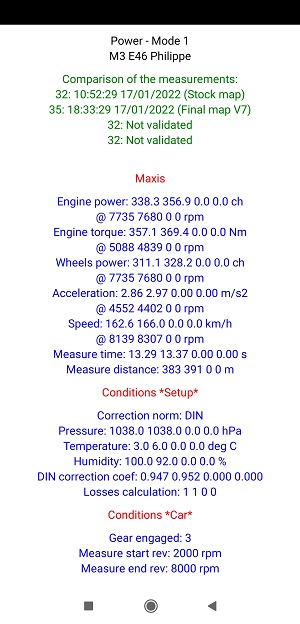
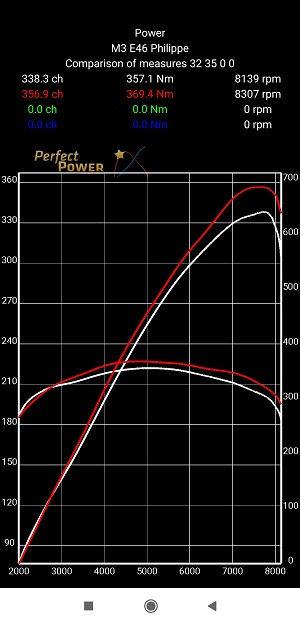
Comparison BEFORE (original map) / AFTER (final map with CSL air box)
Results in imperial system
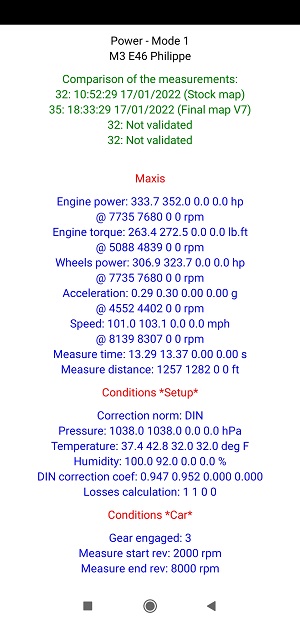
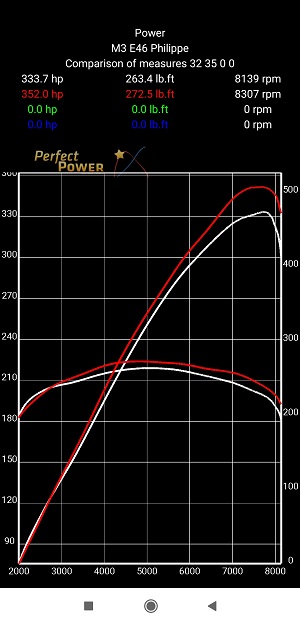
Of course, I used PerfectPower throughout this tuning work (and not only for the initial -original- and final maps!), performing measurements for each tuning & map tested and analyzing the results by comparison / superposition of curves, which allowed me to optimize the mapping of this BMW M3 E46: iwe call this engine development, and when you do it on a chassis dynamometer, it will cost you a few hundred euros & dollars for the rental of the dyno (unless of course you own the dyno yourself, but this will still cost you the trifle of 30,000 to 120,000 euros & dollars for a new dyno...), whereas with PerfectPower, this will cost you only... 49 euros & dollars, and of course you can use it as many times as you want!
As for the efficiency of the development achieved, if you configure and (above all) use correctly PerfectPower, then it will be completely identical between the two equipments!
To complete this illustration, I publish below the results of another BMW M3 E46 of similar mechanical configuration that I tuned the week before on the most efficient chassis dynamometer on the market (a Rotronics Autoscan FI 4x4 synchronized, 120,000 euros & dollars new). I point out that normally I no longer use chassis dynamometer since 2012 since I precisely developed PerfectPower to be able -among other things- to measure and tune myself all the cars I want on the road and with my own tools, but unfortunately for the cars that are not allowed to drive on the road like this BMW M3 E46 prepared for the track, I have no choice!
I let you compare the results between PerfectPower and the chassis dynamometer, you will see that they are identical at all levels: maximum power, maximum torque, maximum power and maximum torque revs, and curves shape! Know that this is perfectly usual with PerfectPower, as I let you check it in the PerfectPower Vs Dynos section (soon available in English), and I am absolutely convinced that PerfectPower will soon supplant chassis dynamometers in the heart of all true sports cars and power and performances measurements enthusiasts...
Results Rotronics Autoscan FI 4x4 synchronized Dyno
_10012022.jpg)
PerfectPower (49 euros & dollars)
356.9 ch @ 7680 rpm
369.4 Nm @ 4839 rpm
Rotronics Autoscan FI 4x4 synchronized Chassis Dynamometer (120,000 euros & dollars)
358.0 ch @ 7632 rpm
369.4 Nm @ 4917 rpm
